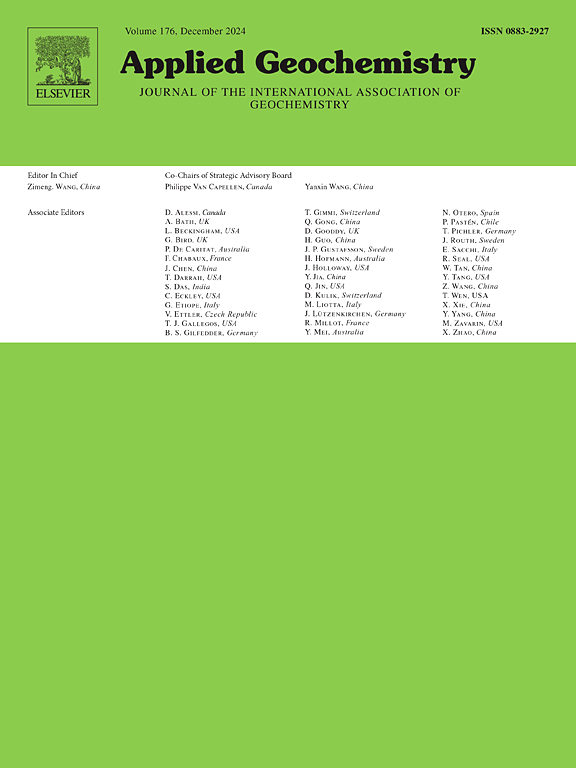Mechanistic model for the cotransport of colloids and radionuclides in saturated porous systems based on the interaction forces between colloids
IF 3.1
3区 地球科学
Q1 GEOCHEMISTRY & GEOPHYSICS
引用次数: 0
Abstract
The presence of colloids in groundwater can enhance radionuclide transport by adsorbing them. In general, colloid transport dominates the process of cotransport. Ripening and site-blocking are two common behaviors in the colloid transport process that are essentially affected by intercolloid forces. In this work, a finite difference model was constructed to describe the cotransport behaviors of radionuclides and colloids in saturated porous media by focusing on the forces between colloids. The proposed model was formulated based on the assumption that the presence of nuclides did not influence colloid transport and ignored the decay of radionuclides in a short period. The one-dimensional advection-dispersion transport of nuclides was coupled with the transport of nuclides in the form of pseudo-colloids. The adsorption and desorption processes of nuclides on media, as well as on mobile or filtered colloids, were considered. Moreover, ripening in the presence of attractive forces between colloids and site-blocking in the presence of repulsive forces between colloids were investigated. The distribution ratios of nuclides in the free solute and in colloidal states during cotransport were reported, and the ripening and site-blocking mechanisms were unified through the force field between colloids. The model was verified by comparing the calculated results with the experimental data. In addition, a parameter sensitivity study was carried out to explore the influence of each parameter on the cotransport process. The model proposed in this paper could be helpful to predict the transport and retention risks of nuclides in porous media containing many colloids.
基于胶体相互作用力的饱和多孔体系中胶体与放射性核素共输运机制模型
地下水中胶体的存在可以通过吸附放射性核素来增强放射性核素的输送。总的来说,胶体输运主导了共输运过程。成熟和位点阻塞是胶体运输过程中常见的两种行为,它们本质上受胶体间力的影响。本文通过关注胶体间的作用力,建立了一个有限差分模型来描述饱和多孔介质中放射性核素与胶体的共输运行为。所提出的模型是基于核素的存在不影响胶体运输的假设而制定的,并且忽略了放射性核素在短时间内的衰变。核素的一维平流-色散输运与伪胶体输运耦合。研究了核素在介质、流动胶体或过滤胶体上的吸附和解吸过程。此外,还研究了在胶体之间存在吸引力时的成熟和在胶体之间存在排斥力时的位点阻塞。报道了核素在共输运过程中自由溶质态和胶体态的分布比,并通过胶体间的力场统一了核素的成熟机制和位点阻断机制。将计算结果与实验数据进行对比,验证了模型的正确性。此外,还进行了参数敏感性研究,探讨了各参数对共输运过程的影响。该模型可用于预测核素在多胶体多孔介质中的运移和滞留风险。
本文章由计算机程序翻译,如有差异,请以英文原文为准。
求助全文
约1分钟内获得全文
求助全文
来源期刊

Applied Geochemistry
地学-地球化学与地球物理
CiteScore
6.10
自引率
8.80%
发文量
272
审稿时长
65 days
期刊介绍:
Applied Geochemistry is an international journal devoted to publication of original research papers, rapid research communications and selected review papers in geochemistry and urban geochemistry which have some practical application to an aspect of human endeavour, such as the preservation of the environment, health, waste disposal and the search for resources. Papers on applications of inorganic, organic and isotope geochemistry and geochemical processes are therefore welcome provided they meet the main criterion. Spatial and temporal monitoring case studies are only of interest to our international readership if they present new ideas of broad application.
Topics covered include: (1) Environmental geochemistry (including natural and anthropogenic aspects, and protection and remediation strategies); (2) Hydrogeochemistry (surface and groundwater); (3) Medical (urban) geochemistry; (4) The search for energy resources (in particular unconventional oil and gas or emerging metal resources); (5) Energy exploitation (in particular geothermal energy and CCS); (6) Upgrading of energy and mineral resources where there is a direct geochemical application; and (7) Waste disposal, including nuclear waste disposal.
 求助内容:
求助内容: 应助结果提醒方式:
应助结果提醒方式:


